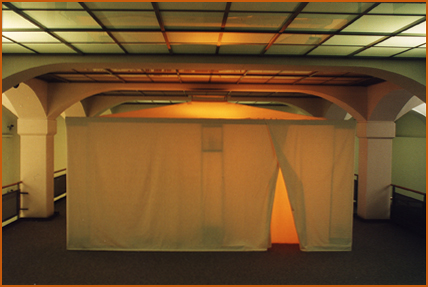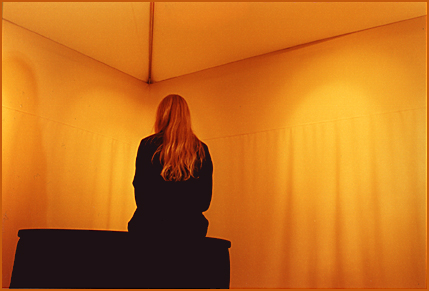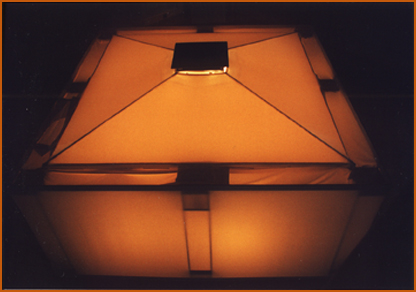<sabine schäfer // joachim krebs>The Set of Projects
|
 |
SonicRooms |
Development of the Space-soundBody "Sonic Tent" in 1997/98
Spatial sound compositions for the Space-soundBody "Sonic Tent":
SonicRooms No.1 (1997/98), eight-channel composition by Sabine Schäfer
SonicRooms No.2 (1998), eight-channel composition by Joachim Krebs
The Accessible Space-soundBody
The set of projects entitled "Sonic Rooms" is our first commonly realized work cycle which does not, as earlier works did, aim at the acoustical staging of the given performing space, which would make the room itself sound, while taking into specific consideration the special conditions offered by the respective location.
Thus, the location of theSpace-soundBody's presentation is not crossed - in this case acoustically - in its architectonic dimensions, a process which would render the room itself "audible".
Quite contrary, the installation aims at the furthest possible elimination of the real - visual as well as acoustical - environment of the place where the traversable threedimensional sounding body - actually a room within a room - is installed. This is especially true for a person who finds her/himself inside the three-dimensional sounding body.
For instance, by the interior of the Space-soundBody entitled "SonicTent" which is - easily as well as effectively - separated from its surrounding space by a double fabric cover, the visual aspect of the artistic design of space and time is excluded to the largest possible extent - an aspect, by which the auditive reception of the artificially created virtual SonicRooms is intensified.
As visual contact, a crucial premise for orientation and localization, is prevented by thin draping which is impervious to light, but permeable to sound, it is possible to create unreal-imaginary "SensorySonicRooms", where actually moving sounds, which are perceived only by the ear, are experienced as an amorphous continuum of fleeting and unpalpable conditions and acoustic atmospheres.
Paradoxically, the artificial three-dimensional perception of sound is even enhanced by real movement. So in order to experience the SonicTent adequately, you have to be there "live", so that you may, for instance, experience the difference between artificially produced spatial qualities in the stereo image and the artificial character of the psychic "inner" perception of space, which is evoked by sounds covering the real distance between two loudspeakers.
Then again, there are artificial "listening islands", which, in a manner that resembles to listening with earphones , exclude the real listening space by means of surrounding fabric covers and carpeting, so that the artificially produced spatial qualities of the three-dimensional sound composition themselves will gain further authenticity. Thus, at these islands it will be possible to undergo new listening experiences, which, among others, may lead to irritations of the "normal" perception of space and time.
In the best of cases, the sounding work of art will evoke a freely flowing space/sound experience, somewhere between the imaginary, psychic inside space and the "real", physical outside space.
Time Becomes Space - Space Becomes Time
 |
SonicRooms |
All modern perception theories are based more or less on the fact that human perceptions of time and space are interdependent. A distance covered by a person - or a sound - in space is perceived in the first place as a time phenomenon, which allows a person to develop, by way of measuring and comparing, a subjective notion of space and time.
Thus, movement in space becomes time. Time periods become spatial distances. The perception of time is realized by perception of space and vice-versa. The sound event actually moving in space turns space into an experience of time. Thus, time is turned into the open, imaginary process of generating imaginary space. Rooms which are open, unbounded, isolated from the linearily directed time flow, serve as representative surfaces for constantly changing processes generating transitions.
Between TemporalSpaces and SpatialTimes, there are manifold variations of IntermediateZones with their IntermediateSpaces and their IntermediateTimes.
All this leads to a dissolution of the real performing space, where time itself stages a linearily-dramaturgical, final-directed notion (of space?).
Instead, the cyclic, nonlinear notion of time releases the wish to get immersed in the psychic inner space, to close out the physical outer space with its real time and its thinking spaces (which are predetermined in their substance) by concentrating on the perception of at first sight uninteresting sound events based on elementary-harmonical, simple sound material and transformations - to unobstruct your eyes, or better your hearing, so you may experience the present as a possiblility of transitions from one moment to the other of freely flowing conditions.
Individual sounding spots/sounding sources are turned by their movement into a practically organically pullulating sound line, which - itself interconnected to build an artificial matrix of time and space - offers acoustic images of SpaceTimeNets floating freely in "nontime".
In the process, space and time proper are turned into interactive perception qualities constantly fluctuating between the "real" and the "unreal" perception of space and time.
Artificial Soundscapes between Pure Realism and Pure Abstraction
 |
SonicRooms |
It is exclusively original sound elements of the three basic categories nature-animal-man that constitute the basic and starting material for a variety of artistic transformation processes. By applying most recent computer supported digital technology, it is possible to render the intrinsic molecular structure of noises and sounds audible and thus available to the acoustic arts - to an extent which hardly fifteen years ago nobody could have dreamed of.
In a so to speak scientific way and by using so-called digital sound processors (samplers), the carefully investigated, quasi acoustically dissected, amorphous, heterogeneous original sound materials of individual particles of noise/sound/tones are generated. The sound processors serve as a complex of interfaces which penetrate the organic sound structure in order to record, molecularize and then transform its variations.
By a continuous, varied interaction of the individual sound components among themselves, iridescent sounding structures arise which display constant changes in their consistency and their density.
Within these multilinear SoundStructures, so-called acoustically "fluorescent" SoundEnvironments thrive on artificially created, self-impelled and self-intensifying loops, their speed and their movement - two parameters undergoing constant changes. These SoundEnvironments again work as an oscillating, symbiotic amalgam between reality and virtual reality which renders the perception of the present more permeable for possible artistic visions - beyond the outdated traditional dichotomies that separate nature from the arts.
These specifically created, organic-artificial InterEnvironments focus on the generation of transitions; in the transformation of the sound itself into "nature/animal/man". It is efficient in the same measure as nature, animal or man is transformed into something "different": pure line, pure colour, pure sound, pure rhythm, pure movement, pure condition etc.
So as soon as water/air (like in "SonicRooms No.1") no longer sounds just like water/air, but is transformed into sound plateaus with their multilinear intensity streams of sound energies which are free of nonmusical-referential meaning, vibrating on a self-impelled basis, substantial sound matter is turned into expressive sound matter.
The chirping of crickets (as in "SonicRooms no.2") mutates gradually into abstract, rhythmic sound figures connected by artificial sound movements with their resulting virtual resonances to form matrix-like SoundColourRhythmGrids.
Thus, the artificial soundscape emerges as an ensemble of expressive matters within the stratified sound system of the horizontal, rhythmic/melodic sound figure and the vertical, resonant-harmonic sounding space.